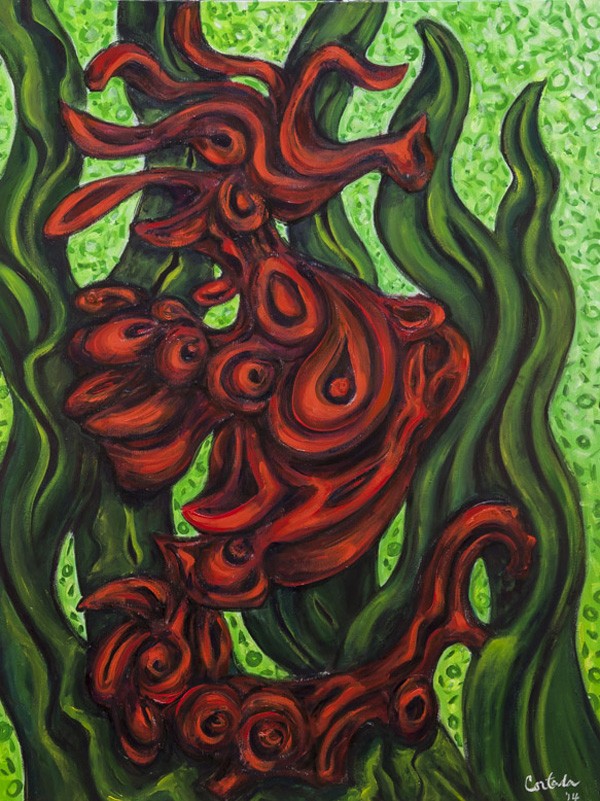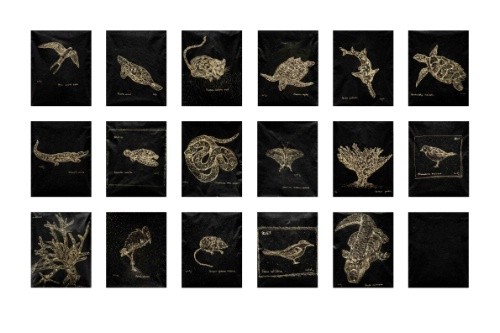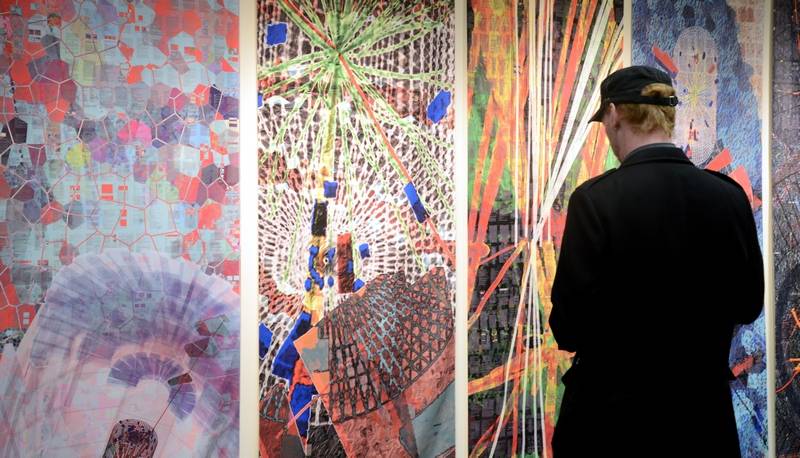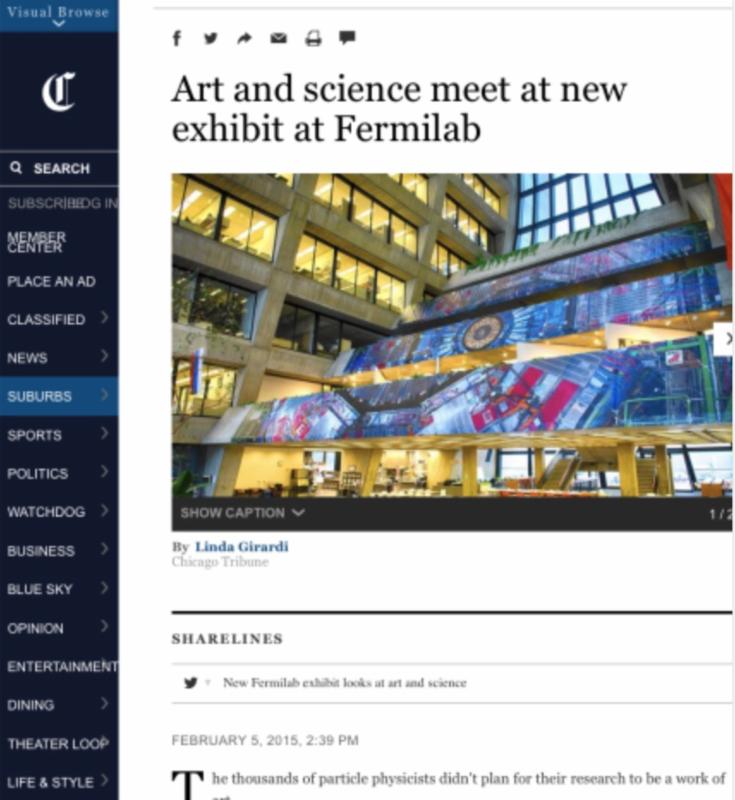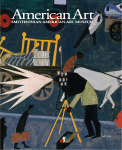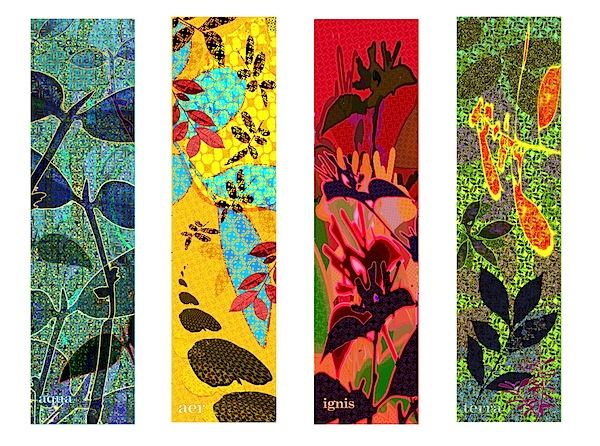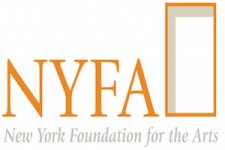Home » Newsletters » 2015 News » February 2015 Newsletter
Forst Art Museum
Wynwood: Bakehouse Art Complex
The Reunion Show
Key Largo: Gallery at Kona Kai
Saving the Seagrasses:
Littoral Creatures
and their Upper Keys Fairchild Challenge student education program.
Chicago: Fermilab Art Gallery
Fermilab employee Rob Snihur of Chicago looks at art by Xavier Cortada and Pete Markowitz at the opening reception Wednesday for Art@CMS at Fermilab in Batavia. Snihur has worked at Fermilab for 12 years and worked on the CMS Detector experiment for five of those years. The CMS Detector is part of the Large Hadron Collider at CERN in Switzerland. Laura Stoecker|Staff Photographer.
Art@CMS: In Search of the Higgs Boson
Visitors to the exhibit will see five banners by artist Xavier Cortada and physicist Pete Markowitz that show various stages of particle collisions recorded by detectors.
Cortada said the banners are in homage to the more scientists and engineers whose research have opened up new avenues in science.
“Artists try to do the same thing. That is why we are such kindred spirits,” Cortada said.
Ontario: McMichael Canadian Art Collection
Vanishing Ice: Alpine and
Polar Landscapes in Art, 1775 – 2012
The exhibit features Cortada’s “Astrid” ice painting; read about it below:
The University of Chicago Press on behalf of the
In 2007 the Miami-based artist Xavier Cortada produced Astrid, a small abstract painting consisting of liquid splotches of blue pigment in a grainy, grayish-white field on paper (fig. 1). The work recalls postwar expressionism of the New York School or later post-painterly abstraction, but such associations only scratch the surface of the picture’s meaning. The more we learn about the artist, his materials, and the context of production, the more we recognize this to be a work of our time, even as it gestures to the past and future. Cortada created Astrid at McMurdo Station, the U.S. Research Center on Ross Island, Antarctica, during a National Science Foundation Antarctic Artists and Writers Fellowship in 2006-7. The picture belongs to a series of mixed-media Ice Paintings that he produced there using ice and sediment samples from the nearby Ross Sea and Dry Valleys of West Antarctica provided by scientists studying climate change. The painting’s title, Astrid, refers somewhat counterintuitively to the King Leopold and Queen Astrid Coast, located far away along the eastern shore of Antarctica. According to the artist, he chose titles for works in this series “by randomly selecting the names of geographic features from a map of the continent that inspired their creation.” Randomness aside, Cortada has asserted unambiguously his environmentalist belief that human beings are “custodians of the planet who should learn to live in harmony with nature.”1
Currently artist-in-residence at Florida International University, Cortada exemplifies the cultural and ecological transnationalism of the twenty-first century. In addition to producing work on commission for the White House, the World Bank, and numerous public collections in Florida, he has collaborated with artists around the world, creating eco-art projects in the Netherlands, Latvia, and Hawai’i, peace murals in Cyprus and Northern Ireland, AIDS awareness murals in Geneva and South Africa, and child welfare murals in Bolivia and Panama. Cortada is an American artist but also self-consciously a citizen of the planet. He describes his most recent series, Ancestral Journeys, a collaborative project with the National Geographic scientist Spencer Wells, as “work that uses genetic data to explore how nature influenced human migration and history,” specifically regarding the various pathways that today’s residents of the Western Hemisphere took from Africa sixty thousand years ago. His point here is that “Perceived differences among people [have] often allowed for exploitation, marginalization, segregation and alienation. Inside our DNA we carry genetic markers that prove that we share the same ancestors and are one human family.”2
Returning to Astrid with Cortada‘s eco-cultural sensibility in mind, we can better appreciate how topical nuances of meaning inflect the work’s evocation of earlier expressionism. For one thing, the Antarctic materials and production site bring to mind recent reports of polar ice melt associated with global warming. Such reports have appeared since the 1970s, but in May 2014 Eric Rignot, a UC-Irvine glaciologist, announced at a NASA news conference: “Today we present observational evidence that a large sector of the West Antarctic ice sheet has gone into irreversible retreat. . . . It has passed the point of no return.” As a result, the world ocean level could rise as much as four feet within the next two centuries, forcing the displacement of millions of people from coastal areas around the globe.3
This may seem like a lot for one small painting to address, but Astrid does so at multiple registers. It creatively conjures the aerial maps and satellite images that scientists such as Rignot use to represent the increasingly unstable environment of Antarctica-a continent whose glacial disintegration has global consequences. Areas of white lightly stained with blue in Cortada‘s work metaphorically suggest continental “landmarks” like the Thwaites Ice Shelf or Pine Island Glacier Basin, which lately have begun to collapse into the ocean. Viewed in terms of materiality instead of metaphor or representation, Astrid functions as a token or specimen of a place undergoing irrevocable change wrought by human actions elsewhere-especially actions associated with Western modernity since the Industrial Revolution. As the artist informed us:
Cortada‘s Astrid provides a fitting introduction to these issues and this series of commentaries, highlighting the significance of ecology as a key concern not only in American art today but also as a defining idea in the history of modernity writ large-an idea whose comprehension demands our acceptance of environmental change as an irrevocable fact of life.
Happy Valentine’s Day!
Please make your charitable donations to the New York Foundation for the Arts, fiscal sponsor of Xavier Cortada’s Participatory Eco-Art Projects, and help engage audiences in addressing global climate change concerns.


